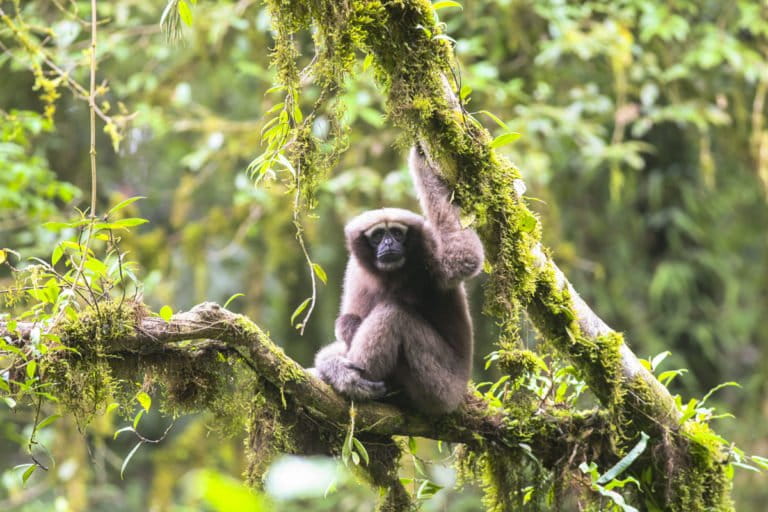- The primate was discovered in the forests of the Gaoligong Mountains, which straddle the border between southwest China and northern Myanmar.
- The species represents a new addition to the genus of hoolock gibbons, also known as white-browed gibbons due to their conspicuous facial markings, which are the second-largest gibbons after the siamang.
- Researchers chose to name the ape the “Skywalker” hoolock gibbon (Hoolock tianxing) in order to reflect its preferred home high in the forest canopy, as well as what they describe as “the historical Chinese view of them as almost mystical beings.”
The force is with a new species of gibbon discovered in Southeast Asia.
The primate was discovered in the forests of the Gaoligong Mountains, which straddle the border between southwest China and northern Myanmar. The species represents a new addition to the genus of hoolock gibbons, also known as white-browed gibbons due to their conspicuous facial markings, which are the second-largest gibbons after the siamang.
The team of researchers that made the discovery was led by Fan Pengfei of Sun Yat-sen University in Guangzhou, China, and also included scientists from the Zoological Society of London (ZSL). The team chose to name the ape the “Skywalker” hoolock gibbon (Hoolock tianxing) in order to reflect its preferred home high in the forest canopy, as well as what they describe as “the historical Chinese view of them as almost mystical beings.”
The researchers described the Skywalker hoolock gibbon in a paper published in the American Journal of Primatology.
There are already two previously-described living species of hoolock gibbon, the western (H. hoolock) and eastern (H. leuconedys) hoolock gibbons, which are geographically separated by Myanmar’s Chindwin River.

But Fan Pengfei and team believed that a population of hoolocks found east of the Irawaddy and Nmai Hka Rivers, which had previously been categorized as members of H. leuconedys, might in fact be a separate species altogether. Based on their study of the genetic characteristics of wild gibbons and museum specimens, as well as their assessment of coat color patterns and tooth morphology, the researchers were able to establish that the Skywalker hoolock gibbon is indeed morphologically and genetically distinct from its cousins to the west.
The newly discovered lesser ape species is already facing an uncertain future. “We consider that the new species should be categorized as Endangered under IUCN criteria,” the researchers note in the study. “The discovery of the new species focuses attention on the need for improved conservation of small apes, many of which are in danger of extinction in southern China and Southeast Asia.”
Dr. Samuel Turvey of ZSL added in a statement that while the team was thrilled to have made this discovery, “it’s also edged with sadness – as we’re also calling for the IUCN to immediately confer Endangered status on the Skywalker hoolock gibbon, which faces the same grave and imminent risk to its survival as many other small ape species in southern China and Southeast Asia due to habitat loss and hunting.”
Turvey said that “Increased awareness of the remarkable ecosystem of the Gaoligong mountains and improved conservation is essential, to ensure we have time to get fully acquainted with this exciting new species before it’s too late.”

CITATION
- Fan, P., He, K., Chen, X., Ortiz, A., Zhang, B., Zhao, C., … & Groves, C. (2017). Description of a new species of Hoolock gibbon (Primates: Hylobatidae) based on integrative taxonomy. American Journal of Primatology. doi:10.1002/ajp.22631
FEEDBACK: Use this form to send a message to the author of this post. If you want to post a public comment, you can do that at the bottom of the page.